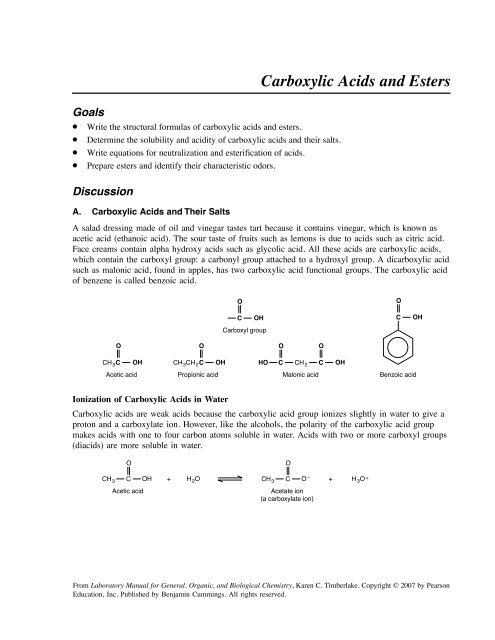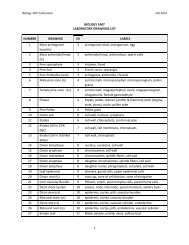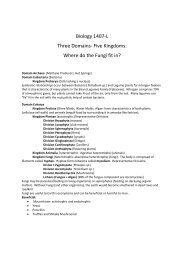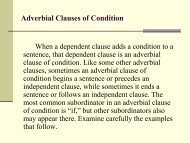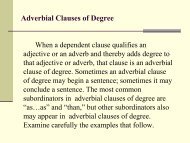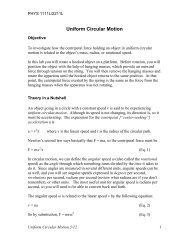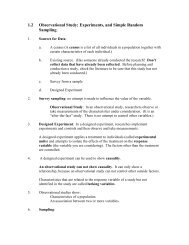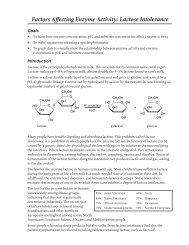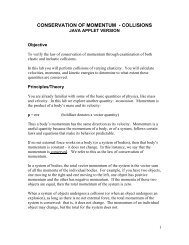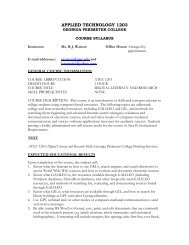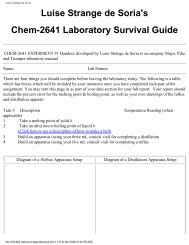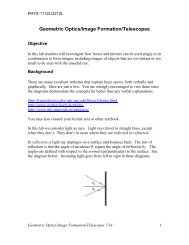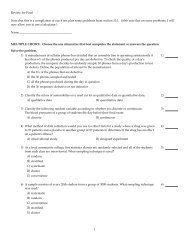Carboxylic Acids & Ester
Carboxylic Acids & Ester
Carboxylic Acids & Ester
Create successful ePaper yourself
Turn your PDF publications into a flip-book with our unique Google optimized e-Paper software.
Goals<br />
• Write the structural formulas of carboxylic acids and esters.<br />
• Determine the solubility and acidity of carboxylic acids and their salts.<br />
• Write equations for neutralization and esterification of acids.<br />
• Prepare esters and identify their characteristic odors.<br />
Discussion<br />
A. <strong>Carboxylic</strong> <strong>Acids</strong> and Their Salts<br />
<strong>Carboxylic</strong> <strong>Acids</strong> and <strong>Ester</strong>s<br />
A salad dressing made of oil and vinegar tastes tart because it contains vinegar, which is known as<br />
acetic acid (ethanoic acid). The sour taste of fruits such as lemons is due to acids such as citric acid.<br />
Face creams contain alpha hydroxy acids such as glycolic acid. All these acids are carboxylic acids,<br />
which contain the carboxyl group: a carbonyl group attached to a hydroxyl group. A dicarboxylic acid<br />
such as malonic acid, found in apples, has two carboxylic acid functional groups. The carboxylic acid<br />
of benzene is called benzoic acid.<br />
O<br />
C OH<br />
Carboxyl group<br />
O<br />
C<br />
OH<br />
O<br />
O<br />
O<br />
O<br />
CH 3 C<br />
OH<br />
CH 3 CH 2 C<br />
OH<br />
HO C CH 2<br />
C<br />
OH<br />
Acetic acid<br />
Propionic acid<br />
Malonic acid<br />
Benzoic acid<br />
Ionization of <strong>Carboxylic</strong> <strong>Acids</strong> in Water<br />
<strong>Carboxylic</strong> acids are weak acids because the carboxylic acid group ionizes slightly in water to give a<br />
proton and a carboxylate ion. However, like the alcohols, the polarity of the carboxylic acid group<br />
makes acids with one to four carbon atoms soluble in water. <strong>Acids</strong> with two or more carboxyl groups<br />
(diacids) are more soluble in water.<br />
O<br />
O<br />
CH 3 C<br />
Acetic acid<br />
OH<br />
+ H 2 O<br />
CH 3 C O – + H 3 O +<br />
Acetate ion<br />
(a carboxylate ion)<br />
From Laboratory Manual for General, Organic, and Biological Chemistry, Karen C. Timberlake. Copyright © 2007 by Pearson<br />
Education, Inc. Published by Benjamin Cummings. All rights reserved.
<strong>Carboxylic</strong> <strong>Acids</strong> and <strong>Ester</strong>s<br />
Neutralization of <strong>Carboxylic</strong> <strong>Acids</strong><br />
An important feature of carboxylic acids is their neutralization by bases such as sodium hydroxide to<br />
form carboxylate salts and water. We saw in an earlier experiment that neutralization is the reaction of<br />
an acid with a base to give a salt and water. Even insoluble carboxylic acids with five or more carbon<br />
atoms can be neutralized to give corresponding salts that are usually soluble in water. For this reason,<br />
acids used in food products or medications are in their soluble salt form rather than the acid itself.<br />
HX<br />
Acid<br />
+<br />
NaOH<br />
Base<br />
Na + X –<br />
Salt<br />
+<br />
H 2 O<br />
Water<br />
O<br />
O<br />
CH 3<br />
Acetic acid<br />
C<br />
OH + NaOH<br />
CH 3<br />
C<br />
O – Na +<br />
+<br />
H 2 O<br />
Sodium acetate<br />
(a carboxylate salt)<br />
B. <strong>Ester</strong>s<br />
<strong>Carboxylic</strong> acids may have tart or unpleasant odors, but many esters have pleasant flavors and fragrant<br />
odors. Octyl acetate gives oranges their characteristic odor and flavor; pear flavor is due to pentyl<br />
acetate. The flavor and odor of raspberries come from isobutyl formate.<br />
O<br />
O<br />
O<br />
CH 3 (CH 2 ) 7 O<br />
C<br />
Octyl acetate<br />
(oranges)<br />
CH 3 CH 3 (CH 2 ) 4<br />
CH 3<br />
O C CH 3 CH 3 CHCH 2 O<br />
Pentyl acetate<br />
(pears)<br />
Isobutyl formate<br />
(raspberries)<br />
An ester of salicylic acid is methyl salicylate, which gives the flavor and odor of oil of wintergreen<br />
used in candies and ointments for sore muscles. When salicylic acid reacts with acetic anhydride,<br />
acetylsalicylic acid (ASA) is formed, which is aspirin, widely used to reduce fever and inflammation.<br />
O<br />
C<br />
H<br />
OH<br />
O<br />
CCH 3<br />
O<br />
O<br />
C<br />
OCH 3<br />
C<br />
OH<br />
Methyl salicylate<br />
(wintergreen)<br />
Acetylsalicylic acid<br />
(aspirin)<br />
<strong>Ester</strong>ification and Hydrolysis<br />
In a reaction called esterification, the carboxylic acid group combines with the hydroxyl group of an<br />
<strong>Ester</strong>ification<br />
O<br />
CH 3 C OH + HO (CH 2 ) 4 CH 3<br />
Acetic acid<br />
H +<br />
O<br />
CH 3 C O (CH 2 ) 4 CH 3 + H 2 O<br />
Pentyl acetate (pear flavor)<br />
1-Pentanol<br />
Hydrolysis<br />
alcohol. The reaction, which takes place in the presence of an acid, produces an ester and water.<br />
The reverse reaction, hydrolysis, occurs when an acid catalyst and water cause the decomposition of<br />
an ester to yield the carboxylic acid and alcohol. The ester product is favored when an excess of acid<br />
or alcohol is used; hydrolysis is favored when more water is used.
<strong>Carboxylic</strong> <strong>Acids</strong> and <strong>Ester</strong>s<br />
C. Hydrolysis of <strong>Ester</strong>s<br />
When an ester is hydrolyzed in the presence of a base, the reaction is called saponification. The products<br />
are the salt of the carboxylic acid and the alcohol. Although the ester is usually insoluble in water, the<br />
salt and alcohol (if short-chain) are soluble.<br />
<strong>Ester</strong> bond splits<br />
O<br />
O<br />
II<br />
II<br />
CH 3 ⎯ C⎯O⎯CH 2 CH 3 + NaOH ⎯⎯→ CH 3 ⎯C⎯ O – Na + + HO⎯CH 2 CH 3<br />
Ethyl acetate<br />
Sodium acetate<br />
Ethanol<br />
(ester)<br />
(carboxylate salt) (alcohol)<br />
Lab Information<br />
Time:<br />
Comments:<br />
2 hr<br />
When noting odors, hold your breath and fan across the top of a test tube to detect<br />
the odor. The formation of esters requires concentrated acid. Use carefully.<br />
Tear out the report sheets and place them beside the matching procedure.<br />
Related Topics: <strong>Carboxylic</strong> acid functional group, ester functional group, ionization of carboxylic<br />
acids, neutralization, esterification, hydrolysis, saponification<br />
Experimental Procedures<br />
BE SURE TO WEAR YOUR SAFETY GOGGLES!<br />
A. <strong>Carboxylic</strong> <strong>Acids</strong> and Their Salts<br />
Materials: Test tubes, glacial acetic acid, benzoic acid(s), dropper, spatula, pH paper, red<br />
and blue litmus paper, stirring rod, 400-mL beaker, hot plate or Bunsen burner,<br />
10% NaOH, 10% HCl<br />
A.1 Write the structural formulas for acetic acid and benzoic acid.<br />
A.2 Place about 2 mL of water in two test tubes. Add 5 drops of acetic acid to one test tube and a small<br />
amount of benzoic solid (enough to cover the tip of a spatula) to the other. Tap the sides of the test<br />
tubes to mix or stir with a stirring rod. Identify the acid that dissolves.<br />
A.3 Test the pH of each carboxylic acid by dipping a stirring rod into the solution, then touching it to a<br />
piece of pH paper. Compare the color on the paper with the color chart on the container and report<br />
the pH.<br />
A.4 Place the test tube of benzoic acid (solid should be present) in a hot water bath and heat for<br />
5 minutes. Describe the effect of heating on the solubility of acid. Allow the test tube to cool.<br />
Record your observations.<br />
A.5 Add about 10 drops of NaOH to each test tube until a drop of the solution turns red litmus paper<br />
blue. Record your observations. Write the equations for the reactions with NaOH including the<br />
structures of the sodium salts formed.<br />
A.6 Add about 10 drops of HCl to each sample until it is neutralized (blue litmus paper turns red).<br />
Record your observations. Write equations for the reactions of the sodium salts that formed.
<strong>Carboxylic</strong> <strong>Acids</strong> and <strong>Ester</strong>s<br />
B. <strong>Ester</strong>s<br />
Materials: Organic model set, test tubes, hot plate or Bunsen burner, 400-mL beaker, stirring<br />
rod, spatula, small beaker, methanol, 1-pentanol, 1-octanol, benzyl alcohol,<br />
1-propanol, salicylic acid(s), glacial acetic acid, H 3 PO 4<br />
B.1 Make a model of acetic acid and methyl alcohol. Remove the components of water and form an<br />
ester bond to give methyl acetate. Write the equation for the formation of the ester.<br />
B.2 As assigned, prepare one of the mixtures listed by placing 3 mL of the alcohol in a test tube and<br />
label it with the mixture number. Add 2 mL of a carboxylic acid or the amount of solid that covers<br />
the tip of a spatula. Write the condensed structural formulas for the alcohols and carboxylic acids.<br />
Mixture Alcohol <strong>Carboxylic</strong> Acid<br />
1 Methanol Salicylic acid<br />
2 1-Pentanol Acetic acid<br />
3 1-Octanol Acetic acid<br />
4 Benzyl alcohol Acetic acid<br />
5 1-Propanol Acetic acid<br />
Caution: Use care in dispensing glacial acetic acid. It can cause burns and blisters<br />
on the skin.<br />
B.3 With the test tube pointed away from you, cautiously add 15 drops of concentrated phosphoric<br />
acid, H 3 PO 4 . Stir. Place the test tube in a boiling water bath for 15 minutes. Remove the test tube<br />
and cautiously fan the vapors toward you. Record the odors you detect such as pear, banana,<br />
orange, raspberry, or oil of wintergreen (spearmint). For a stronger odor, place 15 mL of hot water<br />
in a small beaker and pour the ester solution into the hot water.<br />
If specified by your instructor, repeat the esterification with other mixtures of alcohol and carboxylic<br />
acid. Note the odors of esters produced by other students. Write the condensed structural<br />
formulas and names of the esters produced. Dispose of the ester products as instructed.<br />
C. Hydrolysis of <strong>Ester</strong>s<br />
Materials: Test tube, test tube holder, droppers, stirring rod, hot plate or Bunsen burner,<br />
250- or 400-mL beaker, methyl salicylate in a dropper bottle, 10% NaOH,<br />
10% HCl, blue litmus paper<br />
C.1 Draw the condensed structural formula of methyl salicylate.<br />
C.2 Place 3 mL of water in a test tube. Add 5 drops of methyl salicylate. Record the appearance and<br />
odor of the ester.<br />
C.3 Add 1 mL (20 drops) of 10% NaOH. There should be two layers in the test tube. Place the test<br />
tube in a boiling water bath for 30 minutes or until the top layer of the ester disappears. Record<br />
any changes in the odor of the ester. Remove the test tube and cool in cold water.<br />
C.4 Write the equation for the saponification reaction.<br />
C.5 After the solution is cool, add about 20 drops (1 mL) of 10% HCl until a drop of the solution<br />
turns blue litmus paper red. Record your observations. Determine the formula of the solid that<br />
forms.
Report Sheet<br />
<strong>Carboxylic</strong> <strong>Acids</strong> and <strong>Ester</strong>s<br />
Date ___________________________ Name _________________________________<br />
Section _________________________ Team _________________________________<br />
Instructor _______________________<br />
Pre-Lab Study Questions<br />
1. What are some carboxylic acids you encounter in daily life<br />
2. What are esters<br />
A. <strong>Carboxylic</strong> <strong>Acids</strong> and Their Salts<br />
A.1<br />
Condensed<br />
structural formulas<br />
A.2<br />
Solubility in cold<br />
water<br />
A.3 pH<br />
Acetic Acid<br />
Benzoic Acid<br />
A.4<br />
Solubility in hot<br />
water<br />
A.5 NaOH<br />
A.6 HCI<br />
Write equations for the reactions of the carboxylic acids with NaOH (A.5).<br />
Write equations for the reactions of the salts of the carboxylic acids with HCl (A.6).
<strong>Carboxylic</strong> <strong>Acids</strong> and <strong>Ester</strong>s<br />
Report Sheet<br />
Questions and Problems<br />
Q.1 How does NaOH affect the solubility of benzoic acid in water Why<br />
Q.2 Write the names of the following carboxylic acids and esters:<br />
a.<br />
CH 3 CH 2 CH 2<br />
O<br />
C<br />
OH<br />
b.<br />
O<br />
CH 3 CH 2 C<br />
OCH 3<br />
Q.3 Why are there differences in the solubility of the carboxylic acids in part A<br />
B. <strong>Ester</strong>s<br />
B.1 Equation for the formation of methyl acetate:
<strong>Carboxylic</strong> <strong>Acids</strong> and <strong>Ester</strong>s<br />
Report Sheet<br />
B.2 Condensed Structural Formulas B.3 Odor of Condensed Structural Formula<br />
of Alcohol and <strong>Carboxylic</strong> Acid <strong>Ester</strong> and Name of <strong>Ester</strong><br />
Methanol and salicylic acid<br />
1-Pentanol and acetic acid<br />
1-Octanol and acetic acid<br />
Benzyl alcohol and acetic acid<br />
1-Propanol and acetic acid
<strong>Carboxylic</strong> <strong>Acids</strong> and <strong>Ester</strong>s<br />
Report Sheet<br />
C. Hydrolysis of <strong>Ester</strong>s<br />
C.1 Condensed structural<br />
formula of methyl<br />
salicylate<br />
C.2 Appearance and odor of<br />
methyl salicylate<br />
C.3 Describe the appearance and<br />
odor of the ester after adding<br />
NaOH and heating<br />
C.4 Write the equation for the<br />
saponification of the ester<br />
C.5 What changes occur when HCl<br />
is added<br />
What is the formula of the<br />
compound that formed when<br />
HCl was added


